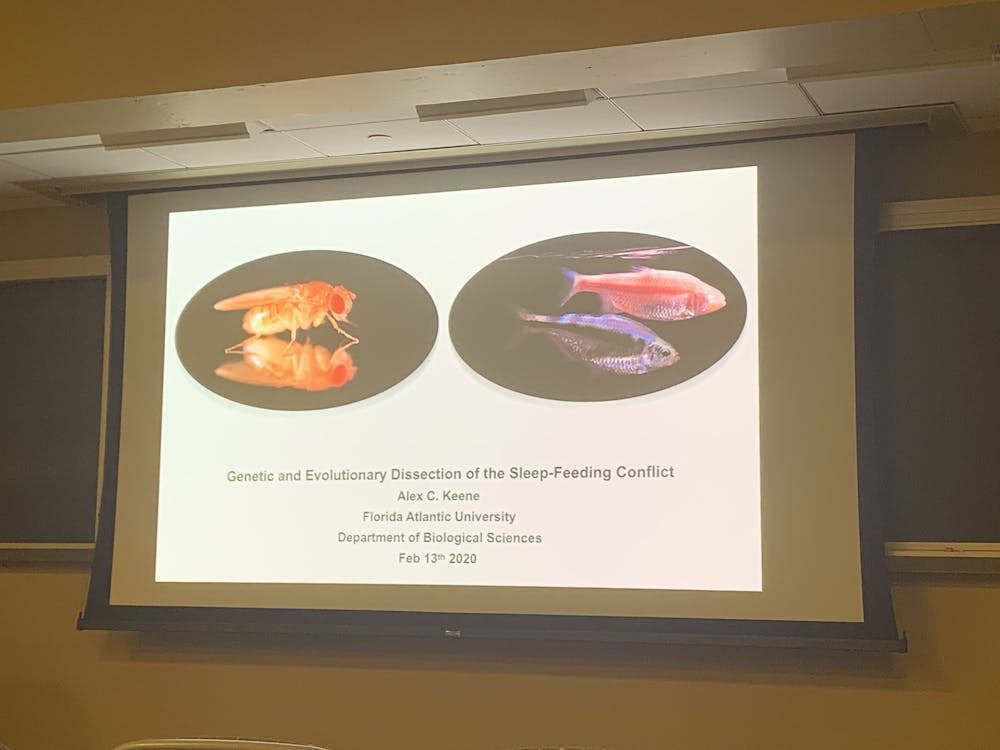On Feb. 13, Alex Keene, an associate professor at Florida Atlantic University, delivered a talk titled “Genetic and Evolutionary Dissection of Sleep-feeding Interactions” for the Department of Biology.
Keene’s research aims to address a central challenge in the field of neuroscience: understanding how genes and neural circuits regulate behavior. His lab is particularly interested in understanding the neural mechanisms that control sleep-metabolism and memory formation in the Mexican cavefish and the fruit fly Drosophila melanogaster.
Disrupted sleep contributes to many metabolic diseases including diabetes, obesity and heart disease.
Keene explained that in order to understand how humans experience disruptions in sleep, scientists often turn to the fruit fly.
“Flies, like mammals, modulate sleep in accordance with their nutritional needs,” Keene said.
Researching sleep-metabolism interactions in flies constitutes a two-step process, according to Keene.
“We need to understand both the novel regulators of sleep-metabolism interactions along with the genes and neural circuits that integrate these processes,” he said.
His lab recently carried out a neuron-specific RNA interference screen of over 1100 different genes, revealing numerous targets that are required for the metabolic regulation of sleep. In particular, this screen isolated translin (trsn), an mRNA/DNA binding protein that is highly conserved from flies to humans and is involved in mammalian metabolic function.
“We discovered that neuron-specific mutations in the trsn locus results in flies that do not suppress sleep during starvation but still maintain normal energy stores,” Keene said. “These mutations are also likely to occur in humans; we just haven’t found them yet.”
Keene’s lab is now studying the cellular and neuroanatomical function of trsn to determine how sleep and metabolic state are integrated. This work will define a critical link between metabolism and sleep regulation, providing new avenues for investigating sleep-feeding interactions that potentially impact human health.
Keene also studies how sleep deprivation causes physiological changes on a neural basis, especially memory impairment.
His lab has identified a dopamine-modulated circuit that controls the formation of aversive taste memory. In addition, it has characterized the taste of fatty acids and identified novel fatty acid receptors in flies.
Keene also studies a question that many college students may grapple with: Why do we need sleep at all?
“Energy conservation is thought to be a central function of sleep,” Keene explained.
His lab has characterized sleep and metabolic phenotypes in flies selected for starvation resistance.
“These flies can live up to two weeks longer on food and sleep than controls. We’re searching for a genetic basis of these sleep changes,” Keene said.
Keene’s lab has also traced the evolution of sleep loss in Mexican cavefish.
“We have been developing this system over the past 10 years to identify novel sleep genes, and understand why sleep varies throughout the animal kingdom,” Keene said. “We are also developing transgenic tools to image brain activity and manipulate neural function in this emergent genetic model system.”
Ultimately, Keene hopes this work will define a critical link between metabolism and sleep regulation, providing new avenues for investigating sleep-feeding interactions that potently impact human health.
Functional investigation of genes regulating sleep-metabolism interactions will provide the groundwork for understanding metabolic regulation of behavior and further our understanding of obesity, sleep disorders and diabetes.





